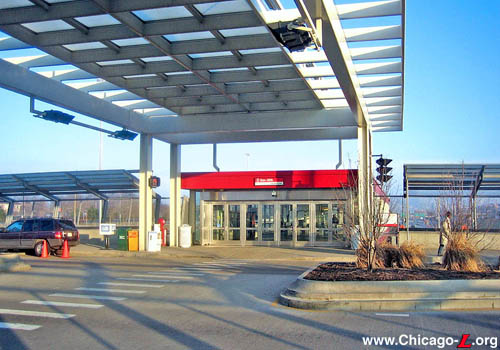
The 35th Street entrance to
the Sox-35th station has changed its appearance
significantly since it was built, as this view shows looking
north on December 24, 2006. Although the Skidmore-designed
International Modern-style station house's structure
remains, the interior was extensively renovated in 1999-2000
and again in 2002-03, and the bridge was rebuilt with median
planters, canopy-cover sidewalks, and a mid-block
postmodern-style canopy in front of the station entrance in
2002-03. The station house's storefront facade was added in
2006. For a larger view, click here.
(Photo by Graham
Garfield)
|
|
Sox-35th
|
|
(3500S/200W)
35th entrance
|
|
|
|
(3300S/200W)
33rd entrance
|
35th Street and the Dan Ryan
Expressway, Armour Square
Service
Notes:

|
Red Line: Dan Ryan |

|
Accessible
Station |

|
Owl
Service |
Quick Facts:
|
Address:
|
142 W. 35th Street
(35th
entrance)
|
|
143 W. 33rd Street
(33rd
entrance)
|
Established: September 28, 1969
Original Line: West-South Route, Dan Ryan branch
Previous Names: none
|
Skip-Stop Type:
|

|
Station
|
Rebuilt: 2000 (elevator
added), 2002-03
(station house
renovation), 2005-06
(station
renovation), 2013 (refurbished)
Status: In Use
History:
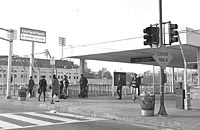
The entrance to the Sox-35th
station, shown as-built on November 6, 1969. Note that the
front portion of the station entrance is covered but not
enclosed, and the utilitarian chainlink fencing on the
expressway bridge. Old Comiskey Park is visible in the
background. For a larger view, click here.
(Photo from the CTA
Collection)
|
The design of Sox-35th and the other eight stations of the Dan Ryan
line were carried out by Skidmore, Owings & Merrill under the
direction of Myron Goldsmith, who developed a modern, functional form
in the late International style popular at the time. Improved
visibility and security, ease of cleaning and more comfortable
working conditions for CTA employee were design goals. Skidmore took the Kennedy-Dan Ryan
("KDR") project in a unique direction, designing all aspects of the
new lines to harmonize in both shapes and materials. All windbreaks,
dividers, and ticket booths were stainless steel. The supports of the
transparent platform canopies and the structures of the station
enclosures are white-painted steel frames, and the enclosures
themselves are glass. The formal and functional criteria were
expressed in several ways: open, uncluttered, brightly lit interior
spaces; durability, safety, maximum efficiency of movement; lightness
and purity of structure. The shape of everything, from the buildings
to the agents' booths, to the trashcans, followed together into a
seamless design philosophy, which perfectly captured the boxy, purely
functional International Modern style for which Skidmore is so well
known.
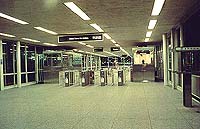
The Sox-35th interior and
fare controls in 1970, shortly after opening. Stainless
steel turnstiles, now an industry standard, were first used
in this and other Dan Ryan stations. Today, all of this has
been removed: the Duncan turnstiles have been replaced by
Cubic farecard turnstiles and the dual agent booths have
been replaced by a single CA booth, where the phone is on
the right. For a larger view, click here.
(Photo from the CTA
Collection)
|
The commemorative brochure published for the event describes the
stations this way:
"Nine stations serve the Dan Ryan Line...
Wide visibility and a high level of illumination are
characteristic features in all areas. Fare collection equipment
and turnstiles are stainless steel and... escalators supplement
stairs for movement between station levels. Stations in the
expressway medians are constructed of steel and glass providing
maximum visibility from adjacent streets and highways. The
boarding platforms are long enough to accommodate 8-car trains...
Steel framed canopies of translucent plastic [extend]
beyond the center line of the tracks. Self-service infrared
radiant heaters are located at windbreaks on the platforms.
Off-street bus transfer facilities are provided
at the 95th Street terminal and at 69th
Street station by means of bus bridges
over the expressway traffic lanes. An off-street bus loop is also
provided at the Cermak
Road station..."
In terms of interior arrangement and design for the passenger,
Skidmore generally followed the edict of modernist pioneer Mies van
der Rohe that ‚ "less is more." Except for at a few locations
(most notably 95th Street terminal), there were no concessions
provided for passengers. Air conditioning and a compact washroom with
a toilet were provided in the agents' booths. Restrooms were for
employees only, though payphones were provided. Stainless steel
turnstiles, now an industry standard, were first used here. The
amenities and traffic circulation fit with the architectural design
of the station: efficient but purely functional. Stations were
designed with wide walkways and no blind corners, with turnstiles and
agents booths arranged for maximum queuing and circulation
effectiveness.
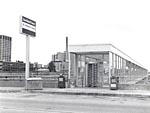
The auxiliary entrance at
33rd Street, seen looking south on November 6, 1969.
Originally, the rotogate that allowed exiting only was built
into the front elevation. It was unlocked during the PM
rush, allowing admittance to an agent on the platform. For a
larger view, click here.
(Photo from the CTA
Collection)
|
The stations' design even formed a harmony with the 150 rapid
transit cars that were ordered to serve the new Kennedy
and Dan Ryan lines,
which used the same design philosophies and basic shapes, and an
entirely new system of signage with a redesigned typeface and clean
graphic style (still used by CTA today, in a modified form), making a fully integrated design
throughout the entire project.
Stations were spaced at between half-mile and one-mile intervals,
reflecting an increasing spacing of stations prominent in the postwar
period, with bus lines acting as feeders to the rapid transit line.
The Dan Ryan and
Kennedy stations
were also set up to allow Pay On Train operation, though without all
of the complicated gates and rearrangement built into the Congress
stations. The translucent skin of the headhouse exteriors made this
type of operation more safe than before, though not necessarily
making it more aesthetically desirable for the customer. The result
was a utilitarian white steel and glass station that is functional
but not particularly ornate.
The station is only feet from Comiskey Park, the home of the
Chicago White Sox baseball team. So, for this reason and to
distinguish it from the 35th Street
station on the Jackson-Park/Englewood Line only a few blocks east,
the station was coined Sox-35th and the other Tech-35th
(for the nearby Illinois Institute of Technology).
One of several reductions in service due to CTA's budget crisis in
the 1970s, on January 13, 1973, the 33rd auxiliary entrance to
Sox-35th was closed (one of many auxiliary entrances closed that
year), reduced to a rotogate-controlled auxiliary exit. 33rd Street
was not reactivated as an auxiliary exit until the late 1990s, when
an unmanned farecard-only High Barrier Gate (HBG) was installed at
part of the CTA's automated fare equipment project, once again allowing both entrance
and exit from this auxiliary location.
Station Remodeling
As part of a set of capital improvements at a number of stations,
the CTA added an
elevator at the 35th entrance at Sox-35th in 2000 as part of an
upgrading of the station to be ADA accessible. This project included
the installation of elevators, blue tactile platform edging, braille
tactile signs, wheelchair gates, and other improvements.
As a result of the new elevator, the stairs had to be relocated to
accommodate the elevator shaft and equipment. Other upgrades made to
the station's main entrance in 1999-2000 included a new Customer
Assistant kiosk, granite flooring in the fare control area, stainless
steel barriers, new mechanical, electrical and communication rooms
and an employee restroom.
The first Current
Graphic Standard station name signs on the Dan Ryan Line were
installed at Sox-35th in early November, 2001, not in the form of
replacements but in addition to the existing station name signs. The
signs that were in place in station windbreaks at the time were the
original signs from when the branch opened in 1969 and were the
prototypes for the KDR
(which stands for Kennedy-Dan Ryan, the lines were they were tested)
signage standard, which the CTA later adopted for the entire system. The KDR
signs were left in place for the time being, with the new signs were
installed in addition to the originals. The new signs were located on
new white steel poles and brackets mounted on the median wall between
the tracks and the Dan Ryan Expressway traffic lanes, thus placing
them facing the platforms rather than on them. Placed only at
Sox-35th and 95th/Dan Ryan at that time, they
are being installed as part of the CTA's upgrading of those facilities to ADA-compliance.
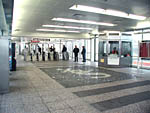
Renovations inside the
Sox-35th station house included a new reflective ceiling,
new lights, new signage, and a new granite floor with an 8'
x 10' Chicago White Sox logo mosaic with a stainless steel
border, seen here on reopening day, April 4, 2003. For a
larger view, click here.
(Photo by Graham
Garfield)
|
The station was further renovated in 2002-03 in conjunction with the
Chicago Department of Transportation (CDOT) reconstruction of the the
35th Street bridge. During construction, Sox-35th's main entrance on
35th was closed temporarily and the 33rd Street auxiliary entrance
was used to access the station. The 33rd entrance, which is normally
only equipped with a High-Barrier Gate for farecard-only access (the
auxiliary fare booth having been removed many years before), was
upgraded with a new customer assistant's booth, turnstiles (relocated
from the 35th Street entrance), new graphics, and a few other modest
amenities. Customers who needed an elevator access used the Roosevelt/State
station with the #29 State bus as an alternate service. Additionally,
the #35 35th and #39 Pershing buses were rerouted and made service
stops at the 33rd Street entrance. The change of service to the 33rd
entrance was originally to have taken place Monday, October 21, 2002
-- and indeed the CTA did close the 35th entrance on this date -- but effective Wednesday,
October 23, the main 35th Street entrance reopened because CDOT
decided to postpone its project (apparently with late notice to the
CTA ). Rather than
inconvenience its customers for a delayed reconstruction project, the
CTA decided to
reopen the 35th entrance until CDOT rescheduled its rebuilding
project. This remained in effect for only two days, with service
shifting to the auxiliary entrance again on Friday the 25th when CDOT
began their reconstruction project.
Station upgrades to the 35th entrance in the $1.5 million 2002-03
renovation included a new reflective ceiling with new fluorescent
lights, troughs of indirect lights suspended from the ceiling along
the outside walls, new signage, and a new granite floor with an 8' x
10' Chicago White Sox logo mosaic with a stainless steel border. The
work also included improvements outside the station house, including
the installation of a mid-bridge canopy over the crosswalk at 35th
Street and the bus stops outside the station, a decorative fence and
railing system along the sidewalks over the expressway, and an art
canopy over the sidewalks. The canopies were constructed of steel and
incorporated colored art glass.
The 35th Street entrance to the Sox-35th station reopened at 0530
hours, April 4, 2003, just in time for the White Sox's home opener
against Detroit that afternoon. With the station completed, the #35
35th and #39 Pershing buses routes returned to their regular routes.
At the same time, the 33rd entrance returned to an auxiliary
farecard-only HBG entrance, with the temporary customer assistant
booth removed and the turnstiles returned to the 35th Street station
house. Although work inside the station was completed by opening day,
work on the 35th Street bridge continued for several weeks. Crews
worked finish installing the two architecturally detailed canopies to
protect pedestrians and CTA users, one along the north side of 35th between LaSalle and
Wentworth, the other across 35th Street. Other items later completed
included new railings, lighting and a median planter.
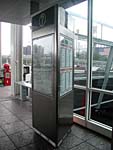
As part of the 2002-03
renovations, a prototype, three-sides information kiosk was
installed inside the Sox-35th main entrance, seen on August
1, 2003. For a larger view, click here.
(Photo by Graham
Garfield)
|
Officials unveiled the remodeled bridge over the Dan Ryan Expressway
at 35th Street on July 14, 2003, completing the renovation project.
The 35th Street improvements were completed in time for the Major
League Baseball All-Star Game at Comiskey Park. As part of the
project, the traffic signals at the intersections of 35th and LaSalle
and 35th and Wentworth, as well mid-block on the bridge, were
modernized. The reconstructed bridge over the expressway also
features sign bands visible to motorists on the Dan Ryan that
highlight two prominent community institutions: the White Sox and the
Illinois Institute of Technology. The large, backlit signs draw added
attention to the area's attractions.
Additional improvements were made inside the station in time for
the All-Star Game as well. A new prototype information kiosk was
installed in the unpaid area of the station house, a few feet inside
the entranceway. The approximately seven-foot tall, three-sided kiosk
has three large 27"x40" display windows which can be used to hold "L"
system maps, CTA system maps,
timetables, neighborhood maps, and other information. The stainless
steel display case was topped with a black band with a white question
mark, denoting its presence and function as an information center.
This three-sided information kiosk was a second-generation outgrowth
of a two-sided kiosk tested at Clark/Lake
under the Frankle-Monigle
signage test. Later variants of this design have been installed
elsewhere on the system (including the Sox-35th platform in 2006),
but as of 2007 this prototype remains at the 35th entrance.
On the platform, new red tabs were added to the Current Graphic
Standard station name signs on the outside of the tracks. The old
blank tabs were replaced with new red tabs with exit information in
white letters and symbols. On each sign, one tab said "33rd " with a
KDR arrow
pointing to that exit and the other said "35th" with an ADA symbol
and a KDR
arrow.
The station and bridge improvements collectively cost more than
$13 million and were funded by the Illinois Department of
Transportation and the
CTA .
Dan Ryan Red Line
Rehabilitation Project
With few major improvements (though with a lot of patching) over
its thirty year life, by the early 21st century the Dan
Ryan Line was in need of a major overhaul. (The improvements made
to Sox-35th detailed above were an exception to the rest of the
branch.) On April 3, 2003, the Chicago Transit Board approved a $4.5
million contract to renovate the 69th
and 95/Dan Ryan bus bridges as well as the
bus turnaround at 95th Street, signaling the beginning of the
rehabilitation of the Dan Ryan branch of the Red Line. The Dan Ryan
renovation project entailed upgrading the infrastructure of the line,
including improving power reliability and delivery of that power, and
providing station improvements to the seven stations on the branch
north of the terminal.
On October 7, 2003, the Chicago Transit Board approved a $192.5
million contract to rehabilitate the Dan Ryan branch, with
Kiewit/Reyes, AJV (A Joint Venture) awarded the construction contract
as part of a competitive bid process. The total cost of the Dan Ryan
rehabilitation program was to be $282.6 million.
The project was executed in three phases. During the first phase
of the project, which extended from March 2004 to May 2005,
CTA replaced crossover track,
installed a temporary signal system to support the track work and
began third rail replacement from Cermak-Chinatown
to 95th. As part of Phase II, which ran
through early 2006, the CTA constructed two new substations and upgraded two existing
substations, installed a permanent signal system and replaced third
rail.
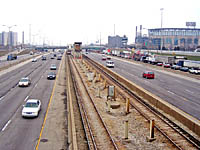
The 33rd auxiliary entrance
bridge wad been removed just a few days before this March
28, 2006 view looking south from the 33rd Street bridge. The
south end of the bridge, housing the escalator down to the
platform, stands opened-ended, as if cut in half by a large
knife, awaiting its new bridge. US Cellular Field is visible
on the right. For a larger view, click here.
(Photo by Graham
Garfield)
|
Phase III improvements, which began at the end of June 2005,
consisted primarily of station renovations. Work at the seven
stations located between Sox-35th and 87th
included refurbishing platform canopies, architectural components,
escalators, the existing station house, and new platform floor
finishes, enhanced lighting, new customer assistant kiosks and
improved signs. Eight escalators along the branch were replaced and
new elevators were installed at 47th and
69th, making those stations accessible
to customers with disabilities. There were also enhancements to
improve bus connections, such as curb cuts, canopies over station
entrances and improved lighting on the approach to each station.
However, because the 35th entrance to Sox-35th was significantly
refurbished in 2003, work at that entrance was more modest, limited
mostly to a new streetside facade with doors and windows to enclose
the station house. The platform and 33rd Street entrance, however,
were more fully renovated.
Sox-35th station remained open throughout the renovation project.
Much of the work was done under single track operations during
midday, owl, and other off-peak hours to allow contractors
Kiewit/Reyes, Aldridge Electric, and others to undertake renovation
work. On many days, it was also common for half of the platform at a
time to be taken out of service at certain stations during owl hours
to provide unobstructed access to the contractors. During some
periods, trains in excess of four cars in length were prohibited from
stopping at certain stations also to provide contractor access.
Effective Monday, June
20, 2005, the 33rd Street entrance was temporarily closed. The
renovated entrance included brighter lighting, refurbishment of the
elevated walkway and canopy, improved signage, and new benches. The
entrance reopened on a temporary basis in Autumn 2005 during baseball
games when the White Sox entered the playoffs and made it to the
World Series, as well as for the Chicago Marathon.
The entrance was
originally scheduled to reopen in late October 2005, but was
initially delayed by having to reopen it for ballgames and the
marathon. Later, while working on the bridge, the structure was found
to be in worse shape than originally thought and it was determined
that full replacement was necessary, requiring it to be closed for a
longer period of time.
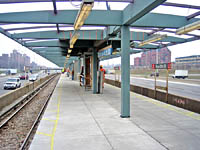
Renovation of Sox-35th is
progressing, as seen looking north on March 28, 2006. With
all of the plexiglas canopy "bubbles" removed, the steel
canopy structure has been refurbished and primed. The new
concrete platform deck poured, but the blue tactile edging
has not yet been installed. Yellow spray-paint has been used
to delineate the "safety zone" along the platform edge. The
new stainless steel windbreaks are in various stages of
installation. For a larger view, click here.
(Photo by Graham
Garfield)
|
During Autumn 2005, the original terrazzo platform flooring was
removed from the remaining station platform. The White Sox paying in
the 2005 World Series delayed Kiewit from getting access to Sox-35th
station until after October 26 (when they won in Game 4) and,
although Kiewit concentrated there for a couple weeks through
mid-November to make up for lost time, winter set in before they
could complete the work there. By December, only the northbound half
of the platform completed; the southbound remained rough concrete
sub-flooring. A wooden railing was installed down the middle of the
station platform separating the finished and unfinished sides because
their flooring was at different levels. Installation of the new
concrete flooring on the southbound (west) half of the Sox-35th
station platform was undertaken on March 11-12, 2006, requiring
closure of that half of the platform and the institution of
back-riding for southbound passengers to reach the station.
Work continued at
Sox-35th throughout Spring 2006. The Sox-35th station temporarily
closed for a weekend from 10pm, Friday, March 24 to early Monday
morning, March 27, 2006 to allow contractors full access to the
Sox-35th platform. Intense work was undertaken during this time,
including refurbishment of the platform canopy structure, which
required the erection of a large tent around the station platform to
keep the dust and particulate nuisance under control. During the
weekend, construction crews also demolished the pedestrian walkway
from the 33rd Street bridge to the platform and renewed the track
from 33rd Street to Cermak-Chinatown.
During that weekend, a "linecut" was in effect -- severing, or
cutting, the Red Line in two -- suspending rail service between
Cermak-Chinatown and 47th
stations. A bus shuttle provided service in between.
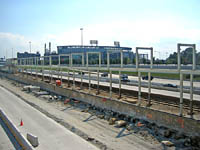
The reconstruction of the
33rd auxiliary entrance bridge had progressed to the point
of the new structural framework being in place in this
September 3, 2006 view looking southwest. Only the bottom
few feet of the columns and their underground footings were
salvaged; everything else was completely rebuilt. For a
larger view, click here.
(Photo by Graham
Garfield)
|
By August 2006, new skylight canopy domes were being installed at
all stations from Sox-35th to 87th. The
station's canopy coverings were installed by the end of summer.
Progress was made on the installation of new vertical access elements
during summer, with installation at of the new escalator completed at
Sox-35th by August.
By mid-November 2006, installation of new station platform canopy
skylight "bubbles" was substantially complete at all stations in the
project zone, from Sox-35th to 87th,
inclusive. Installation of new escalators had been completed at the
35th entrance and was continuing at the 33rd auxiliary entrance.
During November, work also continued on the installation of platform
amenities at all stations, painting station house exteriors and
platforms, installation of new light fixtures on platforms,
installation of new lighting and ceilings in station houses, and
installation of new signage.
Construction continued during Winter 2006-07 on the new 33rd
Street auxiliary entrance and pedestrian bridge. The bridge
structure, floor decking, and roofing was complete by mid-November
and the railings and other fittings were being installed. However,
the Illinois Department of Transportation closed and demolished the
33rd Street bridge over the expressway as part of the Dan Ryan
Expressway rehabilitation, so access to the auxiliary entrance was
cut off during that time.
By the end of 2006, the renovation of Sox-35th station was
substantially complete with only punchlist work remaining, with the
exception of the 33rd auxiliary entrance, on which work continued
into 2007. The finished station included the improvements listed
above and, much like the original Kennedy-Dan Ryan project design by
Skidmore, introduced several elements now standard at Dan Ryan
stations (minus 95th/Dan Ryan and Cermak-Chinatown,
which were not part of the project) including a new type of Customer
Assistant booth (now also used in the renovated Brown
Line stations), windbreak, and combination bench/sandbox. The
station house and platform canopy received red bands as part of its
new paint scheme, providing some color to the facility's exterior as
well as line identification.
Also included as part
of the graphics package were a retrofit of the existing station name
signs mounted outside the tracks on the expressway sidewall, facing
the platform. The frames on which these signs were mounted were
modified to include a stainless steel panel between the posts on the
back of which was mounted an extruded resin
CTA logo facing the
expressway. This was one of several ways the new (as of 2004)
CTA logo was incorporated into
the renovated Dan Ryan stations. The logo was also mounted along the
cornice of all the station houses (typically at the rear end of the
side elevation with with half of the shield extending above the
roofline) and was applied as a hanging station "identifier"
underneath the eyebrow canopy as the stations that received these
coverings.
The rebuilt 33rd Street
auxiliary entrance reopened at 8am, Monday, April 2, 2007. The new
pedestrian bridge features brighter lighting, new ceiling and wall
tiles, and new escalator, and new signage.
Red Line South Reconstruction Project
In 2013, the CTA launched the Red Line South Reconstruction Project, a track renewal project to rebuild the Dan Ryan branch tracks from the bottom up, excavating down to the bottom of the trackbed to rebuild the underground drainage system then installing new ballast, ties, and tracks.
In order to perform the work more quickly and cost-effectively, the CTA closed the Dan Ryan branch for five months while work was performed. During that time, there was no 'L' service on the Dan Ryan branch south of Roosevelt station. Red Line trains were rerouted via the old 13th Street Incline from the State Street Subway to the South Side Elevated, where they operated to Ashland/63rd via the South Side Elevated tracks in a pattern reminiscent of the old Howard-Englewood "A" trains of the North-South Route days. Red Line service to Ashland/63rd began on Sunday, May 19, 2013. Following the five-month track reconstruction and renovation work on the Dan Ryan, Red Line service to 95th resumed at 4am, Sunday, October 20, 2013.
The five-month construction option saved $75 million over an option to perform work on weekends only. CTA invested that $75 million savings into station upgrades along the south Red Line, including lighting improvements, painting, new roofs and canopies at some stations, electrical substation work, and other improvements. In addition, elevators were added to the 87th, 63rd, and Garfield stations, making the whole Dan Ryan branch, and indeed all "L" stations on the whole South Side, accessible.
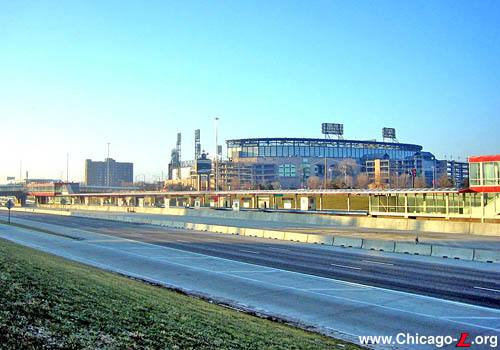
This view of the renovated
Sox-35th station looking southwest from the LaSalle Street
frontage road adjacent to the Dan Ryan Expressway on
December 24, 2006 shows several elements from the
rehabilitation project, including new canopy skylights, new
signage, and the refurbished, repainted station houses. US
Cellular Field, home of the Chicago White Sox, looms in the
background. For a larger view, click here.
(Photo by Graham
Garfield)
|

Sox-35th Station
(1969-1999) |
Sox-35th
Renovation (2000-2003) |
Dan Ryan
Renovation (2004-present)
Sox-35th Station
(1969-1999)
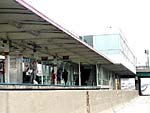
|
sox-35th02.jpg
(100k)
The 35th Street end of Sox-35th, as seen from the Dan Ryan
Expressway looking south. (Photo by Graham
Garfield)
|

|
sox-35th03.jpg
(68k)
The modern, Skidmore-designed entrance at 35th Street to the
Sox-35th station, looking north on November 1, 2001. The
entrance sign over the door and octagonal CA booth inside
are new, installed as part of a Red/Blue Line station
renovation contract that also included making the station
ADA-complaint. (Photo by Graham
Garfield)
|
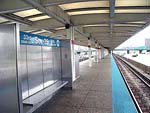
|
sox-35th03.jpg
(??k)
The island platform at Sox-35th, looking south on November
1, 2001. The flooring (save for the blue tactile edging),
canopy, steel windbreak, and KDR signage is all original to
the 1969 facility. (Photo by Graham
Garfield)
|
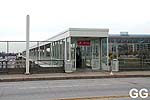
|
sox-35th.33rd01.jpg
(62k)
The 33rd Street Entrance to Sox-35th, looking south on
November 1, 2001. Built as a manned auxiliary entrance with
an agent's booth at platform level, it was closed and made
exit-only in January 1973 as a cost-saving measure. With the
introduction of farecards, 33rd became an entrance once
again, albeit an unmanned one. Comiskey Park, home of the
Chicago White Sox, is in the background on the
right. (Photo by Graham Garfield)
|
 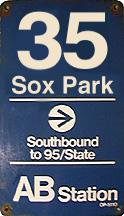
|
sox-35th-P-8_KDRsignNB.jpg (186k)
sox-35thSign.jpg
(20k)
These "KDR"-style
symbol signs from the platform at Sox-35th are typical of this type and vintage: large first letter of the station name (or in the case of stations named for numbered streets, the street's number without ordinals) with the full name under it; a "KDR arrow" pointing in the direction of travel with the direction and destination in the middle; and the skip-stop station type at the bottom. The name used on the signs, "35-Sox Park", differs from the actual name of the station (Sox-35th), which was used on the station name signs; it was likely changed here to keep "35" first and thus as the large type at the top (providing a more instantly-recognizable indicator of the station's location) rather than a large "S" for "Sox". (It is also accurate in that at the time the signs were installed [1969], the name of the ballpark was White Sox Park; the Comiskey Park name, which it had from 1912-1962, was restored in 1976.) The color is also standard -- in the KDR signage system, blue backgrounds were for 'AB' or All-stop stations.
These signs, while very similar to the originals installed in 1969 (which were first-generation signs that established the KDR sign design standard), are actually new versions made in YEAR. The content and overall design is the same as the originals, but several very small changes were made in the replacements: "Sox Park" was made larger in the new versions, "Station" was bottom-aligned with "AB" rather than top-aligned as on the originals, an OP number (a sign artwork catalog number used by the CTA signage department) was added, the corners were rounded rather than squared, and holes with grommets were added to the four corners whereas the originals used a hidden-fastener system. The blue is also a darker blue than was typical for "KDR blue". It's not clear why the signs were replaced or the small graphic design changes were made (the latter likely to better align them with graphic standards for these signs at the time). (NB sign courtesy of Bill Wulfert; SB sign from Graham
Garfield Collection) |
Sox-35th Renovation
(2000-2003)
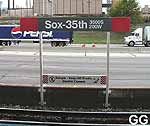
|
sox-35th05.jpg
(90k)
New Current
Graphic Standard signage at the Sox-35th station on
November 1, 2001. The new signs are located on new white
steel poles and brackets mounted on the median wall between
the tracks and the Dan Ryan Expressway traffic lanes, thus
placing them facing the platforms rather than on them. The
original signs on the platform windbreaks were left in
place. (Photo by Graham Garfield)
|
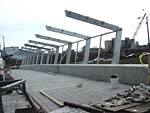
|
sox-35th06.jpg
(79k)
As recently as late March 2003, the new canopies over the
sidewalk on 35th Street were merely a steel framework. By
April 1, they were almost complete. (Photo
courtesy of the Chicago Transit Authority)
|
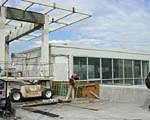
|
sox-35th07.jpg
(78k)
Workers labor to complete the concrete walls and other new
features on the 35th Street bridge in late March 2003.
Within just over a week, the station had to be ready to open
for the first White Sox home game. (Photo
courtesy of the Chicago Transit Authority)
|
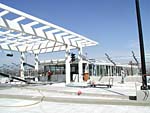
|
sox-35th08.jpg
(163k)
By April 2, 2003, an incredible amount of work had been
completed in short order. The interior fittings were largely
complete and nearly all of the new glass in the station
house exterior curtain walls had been installed. The bridge
decking, sidewalks, curbs and sidewalls were in, and all of
the structural steel for the new canopies was in place.
Although the station house would be ready for opening day
two days later, several of the new amenities outside the
station would not yet be ready, however.
(Photo by Graham Garfield)
|
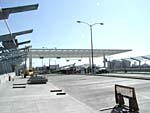
|
sox-35th09.jpg
(133k)
The 35th Street bridge over the Dan Ryan Expressway,
connecting the "L" station to Comiskey Park to the west and
the Illinois Institute of Technology to the east, was
modified to be made more pedestrian friendly. Although still
unfinished on April 2, 2003, the structural steel is in
place for the smaller, angled canopies over the sidewalks
and for the larger one over the mid-block crosswalk and bus
waiting areas in front of the station entrance in this view
looking east. (Photo by Graham
Garfield)
|
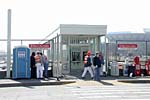
|
sox-35th.33rd02.jpg
(143k)
While the 35th Street entrance was closed from October 2002
to April 2003, the 33rd Street entrance became the primary
access point for the station. Looking southwest on April 2,
2003 with Comiskey Park in the background, the station's had
its second farecard entrance signs replaced with primary
entrance signage and a fleet of newspaper vending machines
stand ready to serve travelers. (Photo by
Graham Garfield)
|
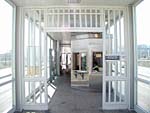
|
sox-35th.33rd03.jpg
(146k)
To serve the number of customers that would be coming
through the otherwise ancillary 33rd entrance, the
high-barrier farecard entrance gate that was normally at
33rd was removed in favor of turnstiles moved from the
closed 35th entrance. A customer assistant booth, seen here
on April 2, 2003, was also installed, since the CA position
was moved from 35th to 33rd and 33rd's original agent's
booth had been removed a couple years previous. Although the
CA booth looks like the octagonal models seen at many new
stations, it was actually fabricated by West Shops personnel
using wood and stainless steel sheathing.
(Photo by Graham Garfield)
|
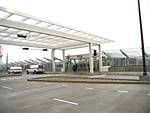
|
sox-35th10.jpg
(134k)
On reopening day, April 4, 2003, all of the important work
had been completed: the station house refurbishing was done,
the street decking was completed and lights were installed.
In spite of the overcast and rainy day, the steel of the
station house and mid-block canopy was freshly painted
hospital white. Although the grating panels on the sides of
the new sidewalk canopies have been installed, much work
still needs to be completed on the sidewalk and mid-block
canopies, including the installation of their roofing.
(Photo by Graham Garfield)
|
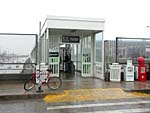
|
sox-35th.33rd04.jpg
(165k)
Upon the reopening of the 35th Street station house, the
33rd entrance of Sox-35th reverted to being a farecard-only
auxiliary entrance. At about 1000 hours on April 4, 2003,
the entrance signage has been replaced and the turnstiles
and temporary CA booth have already been removed, but CTA
crews are still reinstalling the high-barrier gate and
surrounding metalwork. (Photo by Graham
Garfield)
|
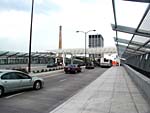
|
sox-35th13.jpg
(142k)
The 35th St. bridge was rebuilt with median planters,
canopy-cover sidewalks, and a mid-block postmodern canopy in
front of the station entrance, seen looking east on August
1, 2003. (Photo by Graham
Garfield)
|
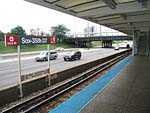
|
sox-35th16.jpg
(206k)
sox-35th17.jpg
(235k)
As part of the renovations, the rebuilt bridge features sign
bands visible to motorists on the Dan Ryan that highlight
two prominent community institutions: the White Sox on the
west half of the span (nearest to the ballpark, in the
bottom photo) and the Illinois Institute of Technology on
the east half (nearest the campus, in the upper photo). The
large, backlit signs will draw added attention to the area's
attractions. Also installed were new station name sign tabs
that denote the stop's two exits, all seen looking north on
August 1, 2003. The new Comiskey Park is visible on the
right. (Photos by Graham
Garfield)
|
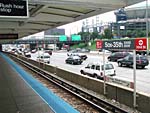
|
|

|
sox-35th14.jpg
(178k)
The 35th Street entrance to the Sox-35th station has changed
its appearance significantly since it was built, as this
view shows looking north on August 1, 2003.
(Photo by Graham Garfield)
|
Dan Ryan Renovation
(2004-present)
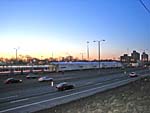
|
sox-35th18.jpg
(145k)
Over the weekend of March 24-27, 2006, the Sox-35th station
temporarily closed to allow contractors full access to the
Sox-35th platform. Intense work was undertaken during this
time, including refurbishment of the platform canopy
structure, which required the erection of a large tent
around the station platform to keep the dust and particulate
nuisance under control. With work trains lined up south of
the station, crews are taking down the tent on the evening
of Sunday, March 27, 2006, looking northwest, in
anticipation of reopening the station for Monday
morning. (Photo by Graham
Garfield)
|
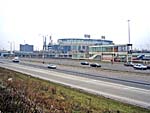
|
sox-35th20.jpg
(173k)
Sox-35th station is seen in mid-renovation looking southwest
from LaSalle and 33rd streets on March 28, 2006. The canopy
is undergoing refurbishment and still lacks its plexiglas
roofing, while the vertical access enclosure at the north
end of the platform ends abruptly in midair, now lacking the
elevated bridge to 33rd Street. US Cellular Field looms in
the background. (Photo by Graham
Garfield)
|
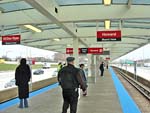
|
sox-35th22.jpg
(158k)
This view looking north on the Sox-35th station platform on
November 11, 2006 shows several elements from the station's
2005-06 renovation, including new concrete flooring,
refurbished canopy structure and new skylight "bubbles", new
signage, and new Dan Ryan-standard stainless steel seating
and windbreaks . (Photo by Graham
Garfield)
|
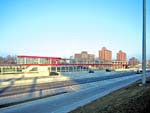
|
sox-35th.33rd07.jpg
(142k)
The new 33rd auxiliary entrance walkway is getting closer to
completion in this December 24, 2006 view looking northwest
from LaSalle Street. By this point, the structure is
completed, the flooring is in place, and railings and other
fittings are being installed. One key ingredient missing:
the 33rd Street bridge! IDOT has demolished the bridge for
reconstruction as part of its expressway renovation, rending
the entrance temporarily inaccessible to pedestrians.
(Photo by Graham Garfield)
|
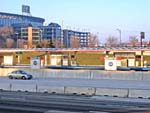
|
sox-35th24.jpg
(163k)
The refurbished Sox-35th platform, seen looking west on
December 24, 2006, shows many of its improvements, including
the new platform flooring, refurbished canopy with new
skylights, new signage including expressway-facing
CTA logos, and Dan
Ryan renovation-standard stainless steel
windbreaks. (Photo by Graham
Garfield)
|

|
sox-35th.33rd08.jpg
(156k)
The renovated 33rd auxiliary entrance is seen looking south
on April 1, 2007, the day before it reopened. The structure,
fittings, signage, and fare control equipment have all been
installed and the entrance would be activated in time for
the White Sox 2007 home opener the next day. Construction
fencing remained around the entrance because CDOT was still
completing the reconstruction of the 33rd Street bridge over
the Dan Ryan Expressway. (Photo by Graham
Garfield)
|
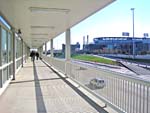
|
sox-35th.33rd09.jpg
(160k)
The new 33rd auxiliary entrance bridge is seen looking south
on April 5, 2007 with the US Cellular Field, home of the
Chicago White Sox, in the background. The renovated 33rd
entrance featured a completely rebuilt bridge deck, roof,
and fixtures. The renovated bridge is interesting in that
the east elevation features a nearly-floor-to-ceiling glass
wall, while the west elevation is open with a side railing.
The rebuilt bridge also features new, brighter lighting, a
reflective ceiling, and a new escalator.
(Photo by Graham Garfield)
|
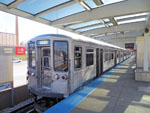 |
cta2318.jpg (215k)
Car 2318 is at the front of a 4-car train of 2200-series cars posed at Sox-35th on a CERA fantrip on November 18, 2012. The trip featured excursions on CTA's oldest and newest cars, the 2200s and the 5000s respectively. The 2200-series cars are at home at Sox-35th, as they were procured for the opening of the Dan Ryan line on which Sox-35th is situated, and their aesthetics were designed to harmonize with the Dan Ryan's modernist stations. The 2200s were being retired with the arrival of the 5000s, and would disappear from the system less than a year later. (Photo by Graham
Garfield) |
|

|

|







































